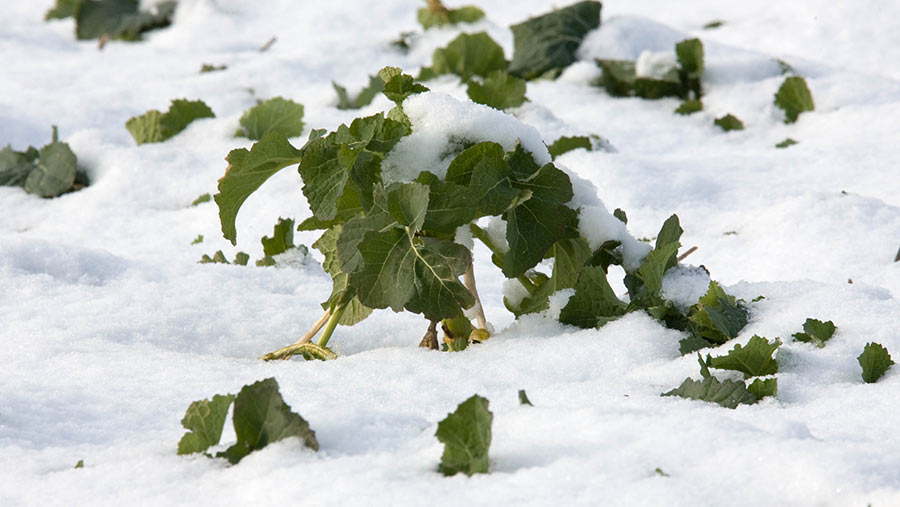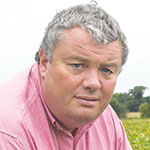Crop Watch: Early nitrogen and sulphur a priority for rapeseed
 © Tim Scrivener
© Tim Scrivener After a week of arctic cold that saw fields disappear under snow, early applications of nitrogen and sulphur on oilseed rape crops have become a priority for our Crop Watch agronomists.
They urge growers to be wary of using products and doses that could over-regulate the growth of rapeseed crops as they grow out of these stressful growth conditions.
Meanwhile, light leaf spot is still a concern in rapeseed, and assuming that the cold snap will have dealt with it could be a mistake.
See also: Frosty weather could cut costs for Hertfordshire wheat grower
South: Iain Richards
Agrii (Oxfordshire)

Winter oilseed rapes were just starting to move, earlier-drilled wheats were carrying too much disease for comfort and spring barleys were just starting to go in after the longest dry spell of the winter. But that was a week ago.
The Siberian blast of the past seven days has stopped everything in its tracks. It’s been a real game-changer – almost certainly for the better in most cases.
With good-sized canopies and spring in the air, we were holding off on fertilising our rapeseed. We were also planning some early growth regulation and reckoning the main pigeon risk was well behind us.
After the sort of cold spell we haven’t seen for several years, early nitrogen and sulphur have become a priority for our rapeseed crops as soon as the weather starts to warm again.
Valuable natural canopy regulation means we won’t now be in any rush with our stem extension sprays; especially as November prothioconazole has kept light leaf spot, as well as any phoma, under first-class control.
Feathered fiends
Pigeons could well be a fly in the ointment. We’re just seeing serious flocking up for the first time this winter and know how damaging late grazing can be when growing points are higher and crops are opened up but not growing away, so we are redoubling our deterrent efforts.
January-applied propyzamide has done a fantastic grassweed control job, as has bifenox on the charlock – with much less effect on crops than we’ve seen in the past following our determined effort to apply it only when the leaves were bone dry. Both will be helped by the cold.
The cold should calm down both growth and disease levels in generally thick, well-tillered crops of early-drilled wheats. Depending on how long it lasts, the more yellow and brown rust-susceptible varieties may well still need a curative T0.
The cold should also reinforce the excellent blackgrass control our robust pre- and peri-emergence herbicide programmes have given here, in contrast to cultivated stubbles, which have seen surprisingly large amounts of late blackgrass germination.
East: Sean Sparling
AICC/SAS Agronomy (Lincolnshire)

A foot of snow equates to an inch of water, so once melted it is going to further delay spring drilling and make land work a challenge.
Wet soils mean only a fraction of the spring barley that we’d expect to have in the ground is drilled – in fact, this is the first time for 15 years that I have none up in rows going into March.
The lying snow will have insulated crops, so once melted, every disease and weed that was there before will remain there, although with some overnight temperatures down to -7C before the snow, it’s probably been cold enough to kill any aphids that were still about.
Before the snow came, light leaf spot levels remained low and under control in oilseed rape, although they had begun to increase with a few milder days.
Light leaf spot still a threat
Assumption is the mother of all cock-ups, so assuming that light leaf spot has been dealt with could easily be a mistake. We only have protection against light leaf spot and so until things become milder it will remain in the latent state.
If in doubt, the free SpotCheck sampling initiative is still available to help determine which diseases are in the crop and at what level. Failing that, a handful of leaves in a polythene bag left in the airing cupboard for 48 hours will encourage sporulation and help determine whether it’s light leaf spot you’re seeing.
Few have managed to get the first dose of nitrogen plus sulphur on oilseed rape, but as soon as the snow goes, I’m sure there will be ruts aplenty and a manic rush to do so.
Septoria and yellow rust levels in winter wheat are lower than last year, although neither are difficult to find. It’s going to be a complicated, untidy and stressful spring. Bring it on!
North: Andy Goulding
CAS/Hutchinsons (Cheshire)

The weather had started to become a little drier over in the wet North-West, until the “beast from the east” swept in and froze fields. This has allowed some growers who really can’t bear another day in the yard a precious respite – enabling them to get out spreading fertiliser or drilling the odd spring crop.
Early-ish drilled cereals look well on the whole, but some are inevitably turning yellow and others purple as nutrition is running out or difficult to access.
Although temperatures are low and there is little foliage on our late-drilled wheat, septoria can still be found (but only the very odd fleck of rust).
Over-regulation
Results from tissue analysis have revealed large infection levels of light leaf spot in oilseed rape. This unobtrusive disease can be easily overlooked, but it needs to be treated as soon as possible with an appropriate dose of azole.
Some crops are not carrying large canopies, so be wary of using products and doses that could over-regulate their growth as they grow out of these stressful growth conditions.
The forecast doesn’t look much fun for planting of spring crops, with showers forecast on most days. Fields which have been subject to less intense cultivation, and those that have had a growing cover crop are likely to be the first available for cultivating or drilling – so long as the cover crop isn’t restricting the wind as a drying aid too much on heavier soils.
With plenty of fields untouched since the date of drilling, there are plenty of weed control jobs which will need to be completed as soon as some consistent active growth resumes. I always encourage growers to use residual herbicides where possible to keep crop safety as top priority.
When the weather breaks there will be lots to do and some tank mixes may be put together for convenience, which could impede essential early growth.
South-West: Stephen Harrison
AICC/Southwest Agronomy (Avon)

As quickly as it came, the extreme weather has now left us. A walk with the dog around a few local crops on Sunday morning revealed them to be in good order now that the snow cover has gone.
The major victims of the chill have been charlock plants, which have decidedly not enjoyed the freeze followed by the thaw. Had the snow come a little later when the rape was into stem extension, things could have been very different.
We will need to be aware of frost heave and the likely need for spring rolling, especially in winter oats as the soils return to something like normal conditions
Winter barley is well tillered except for heavy wet soils. Net blotch is prominent, especially where second crops of winter barley are being grown to balance up rotational blocks.
The frost has resulted in leaf loss particularly where mildew was present. The priority is to apply nitrogen as soon as we can travel.
Spring beans
Wet soils and the big freeze mean little or no field work has been possible. Spring barley seed remains safely tucked up in the sheds. Once drilling is under way we will be sure to get some nitrogen into the seed bed.
Winter wheat has come through the winter well. We have a little blackgrass (the real “beast from the east”!) to tidy up but autumn pre-emergence treatments have performed well. Moist soils, cooler weather and later drilling have all contributed.
Spring beans are often seen as the poor relations of spring crops. We still grow an area of them finding them useful to stretch rotations and give us fantastic first wheats.
A major cost saver and margin improver is home-saved seed. I am pleased to report that the sample I have tested this year has good germination and is free from stem nematode, which was a big issue last year.
Tip of the week
Some crops are not carrying large canopies, so be wary of using products and doses which could over-regulate their growth as they grow out of these stressful growth conditions. Andy Goulding

